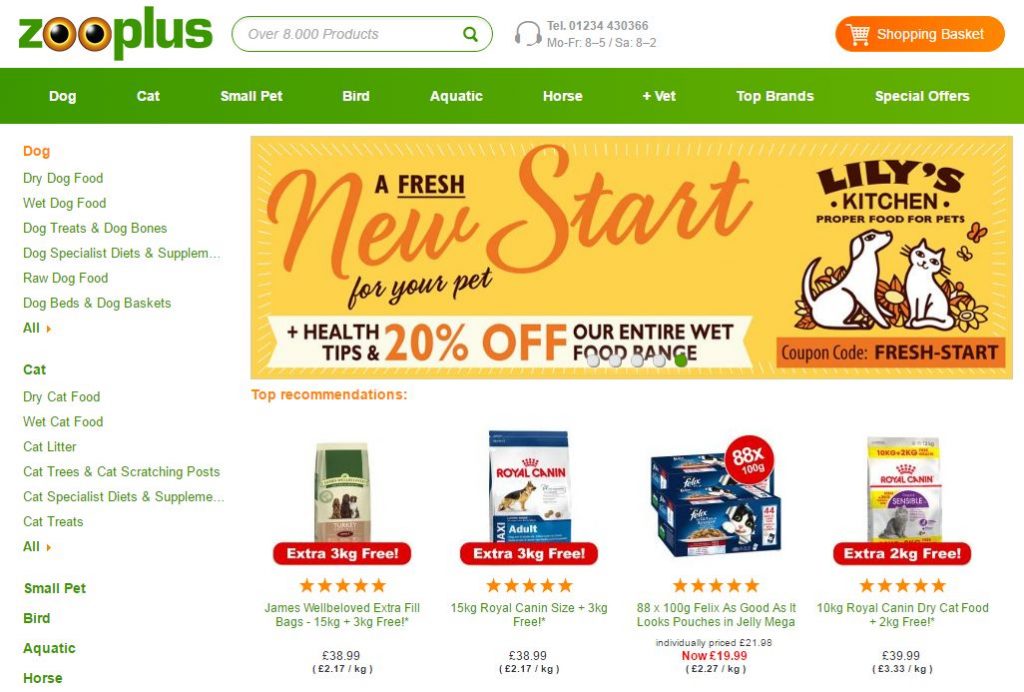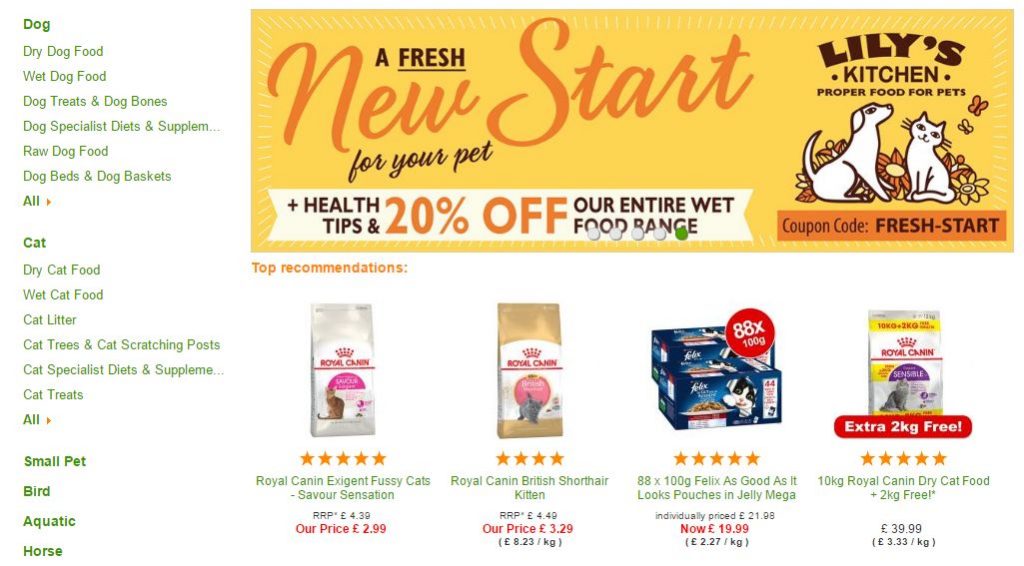Every product in every retail segment – Consumer Electronics, Apparel, FMCG or Pet Products – requires a different sales approach. For example, in Pet Products, you have the two rival audiences: cat owners and dog owners. Start recommending a dog owner cat food, and you’ll see a burst of indignation. Given the situation, it is vital for a Pet Products online retailer to pay attention to the in-store algorithms generating product recommendations.


From this post, you are going to learn about the Progressive Personalization technology and the significant benefits it holds for every owner of a Pet Products online store.
First, let’s answer the question why the product recommendations quality is so important in this retail segment.
Reason #1. Unique User Properties
In the Pet Products retail segment, each product is targeted at the specific pet type: from food formulas and multivitamins to bowls and toys, each item has its unique user. The breed furthermore narrows down the choice, as the item that fits a small dog won’t be suitable for a middle-sized or a big one.
Reason #2. Force of Habit
A repeated practice leads to a habit: the pet gets used to the particular food formula and the owner – to the brand keeping regularly purchasing its products.
The product recommendations that interfere with the habit are likely to be dismissed as intrusive and awkward, the owner thinking: “I need a 5-pound bag of one of the Natural Balance formulas. Huh.., what is that you’re recommending – Pedigree? Weird… No, thanks!”.
Reason #3. Love Sweet Love
It should have been the reason #1. Pet owners adore their pets and see no harm comes to them. Their affection makes them spend days reading books or various forums on how to better look after their pet, and hours of chatting with each other while walking their little friends (not so little sometimes).
As said before, different pets have different unique properties; small kittens and lactating cats need one particular type of food and multivitamin formulas, while sick domestic animals need another. In many situations like the two described, owners are very meticulous about their choice.
Many small dog owners buy their short-haired friends warm clothes when it starts getting colder. A lot of pet owners like to spoil their pets on occasion. A holiday or a pet birthday party surely calls for a treat.

So, when an owner is e-shopping the following key factors are responsible for the purchase decision:
- Type of the pet. A tarantula owner won’t look for a fish food formula, and a cat owner won’t buy dog multivitamins.
- The breed and the size. A Rottweiler needs a bigger serving than a Chihuahua. Also, each breed has its weaknesses, which means different multivitamins and supplements.
- Age of the pet. Recommending a kitten nurturing formula to an owner of a twelve-year-old cat is pointless, as an old pet needs a completely different nutrition plan.
- Brand. Pet owners are often inclined to stick to one familiar brand, it becoming a habit both for the owner and the pet.
- Purchase frequency. The most popular product in this retail segment is the dry food formulas (in 2016, cat and dog dry food formulas are responsible for generating $13,000,000 revenue in the USA alone). This product has a very stable buying pattern, which leads to a scenario where an online store can successfully promote itself by reminding the owner about an upcoming shopping session.
The Progressive Personalization technology enables you as an online store owner to gather and apply all this data to give your clients a highest quality customer experience and to generate your store significantly better sales.
Examples of Progressive Personalization
These days, every online store features regular and recommended products in its catalogue. The difference between standard recommendation algorithms and the Progressive Personalization algorithms is that the second strongly rely on the key parameters described above. Besides, the Progressive Personalization type of recommendations are always data-driven as the system analyzes the on-site customer behavior in real-time learning every new detail about the pet and recommending the items that are sure to be suitable for this user’s pet.
Zooplus features a block of recommendations on the main page. You’re likely to have one too on your main page. A first-time visitor sees a mixed product selection, for various pet types and breeds.

A first-time visitor sees a mixed product recommendations for cats and dogs of different breeds and sizes
However, after a mere two clicks, the recommendation algorithms make the first deductions about the visitor’s needs. In this example, the visitor added to the cart a cat food formula. It is a clear sign this person has a cat and wouldn’t be interested in dog products.
Look at the immediate changes on the main page:

All the recommended products turned to products for cats. The store doubled the amount of potentially suitable products: instead of a half potentially suitable products (2 for cats or 2 for dogs), the store shows a whole block of them (4 products for cats). This way the store doubles the selling power of this block.
As you remember, pet type is not the only key factor responsible for the final purchase decision. The next two important factors are the breed and the size of the pet. At Chewy a visitor interested in food formulas for small dog breeds will see only the individually suitable products:

Each of the recommended items fits the pet type and also the breed and size:

The age and health status of the pet are also key factors in this retail segment. The system analyzes each pet owner’s behavior in real time and, through it, deduces important details about the pet(s). The fact that the customer is looking at this milk replacer for newborn kittens up to 6 weeks old, and for pregnant and lactating cats is a key piece of information (if the store plans on using this information of course):

The correct conclusion drawn from the fact that the visitor is perusing this product is that this person either an owner of a pregnant cat or a newborn kitten.
Relying on this information, recommendation engine reshapes the product recommendations:


These are real examples of successful personalization, the way it should ideally be done everywhere. Especially in the situation, where a product choice is a delicate problem that requires an individual approach in every case.
If the Store Is Lacking Progressive Personalization
Commonly enough, online stores specializing in pet supplies, food and products choose to ignore the basic rules of correct personalization, which inevitably ends in a useless type of products recommendations lacking any value both for the store and its customers.
In the screenshot of one of the Pet Shop USA pages, you can see a pack of food mix for smaller birds.

![]()
The store chose a very basic tactic – to recommend only discounted products. However, all three are dog products, which renders them useless for a bird owner viewing this page.
Underlying Mechanics of Progressive Personalization
This technology also stands out by its smooth and transparent computational logic. To give you a better understanding of the process behind the result, here is an example of the calculations. We start with the main rule to follow in your personalization.
Progressive Personalization rule: pet owners always shop for the pet type they own, and almost always – the breed. Less significant, but still important parameters affecting the final purchase decision in this retail segment are a pet size, age, and a product brand. Recommended products should correspond with these parameters.
First, let’s organize the initial data in a table (for the sake of simplicity, we limited the variables to 2 pet types and 3 breeds):
| Product | Pet type | Breed |
| SKU #001 | Dog | Pug |
| SKU #001 | Dog | Pug |
| SKU #001 | Dog | Terrier |
| SKU #001 | Cat | Bobtail |
| SKU #001 | Cat | Bobtail |
| SKU #001 | Dog | Terrier |
| SKU #001 | Dog | Pug |
| SKU #001 | Dog | Pug |
Next step is to track the activity of the visitor and confirm hypotheses based on that. In this retail segment, there is a probability of an accidental view, for example when the visitor clicked on a banner with an attractive offer but ultimately found the product unfitting.
The store is making a hypothesis on the pet type and breed:
| Pet type | Breed | Scores | Probability |
| Dog | Pug | 4 | 50% |
| Dog | Terrier | 2 | 25% |
| Cat | Bobtail | 2 | 25% |
After the first 8 browsing events, a store with Progressive Personalization inside knows there is a 50% probability this visitor owns a pug and is looking for the products designed for this breed, hence should mostly be recommended products for this breed.
More browsing will narrow down the probability, and the recommendations will progressively improve in relevance. The “weight” of an event will also add to the calculations, as one purchase event tells your store more than 5 browsing events, which may happen by chance, unlike a purchase.
This way, another type of on-site actions, such as adding to the cart and purchasing, bring more complexity into the computational logic. At REES46 Technologies, where we’ve been engaged in the personalization business for more than 7 years, we’ve deduced the following correlation:
| View | 1 score |
| Cart | 5 scores |
| Purchase | 10 scores |
If a visitor viewed 8 cat products but ultimately bought a dog food formula, the dogs “win”. The recommendation system confirms the dog owner hypothesis and transforms the recommendations accordingly.
Let us refresh the calculations based on the newly added parameters:
| Type | Breed | View | Cart | Purchase | Scores | Probability |
| Dog | Pug | 4 | 0 | 0 | 4 | 17% |
| Dog | Terrier | 2 | 0 | 10 | 12 | 52% |
| Cat | Bobtail | 2 | 5 | 0 | 7 | 31% |
The recommendation system deduced that the visitor is an owner of a middle-sized terrier, and start recommending the suitable products.
This logic can be applied in the calculations of any other parameter: a pet age, various health conditions or individual brand preferences.
In Conclusion
Pet Products is a segment where the final purchase decision is affected by a variety of specific factors, such as a pet type, breed, age, health conditions, brand preferences and many others.
The Progressive Personalization technology relies on a clear computational logic, which doesn’t make it any less effective. The PP-driven product recommendations are capable of learning a visitor’s profile within the first several on-site clicks and show individually suitable products after a couple of minutes on the site.
The PP-driven products recommendations have proved to rise online sales by 24% on average, a result worth your effort and time to implement it into your store.


